The 2TB Samsung 850 Pro & EVO SSD Review
by Kristian Vättö on July 23, 2015 10:00 AM ESTMixed Random Read/Write Performance
For full details of how we conduct our Iometer tests, please refer to this article.
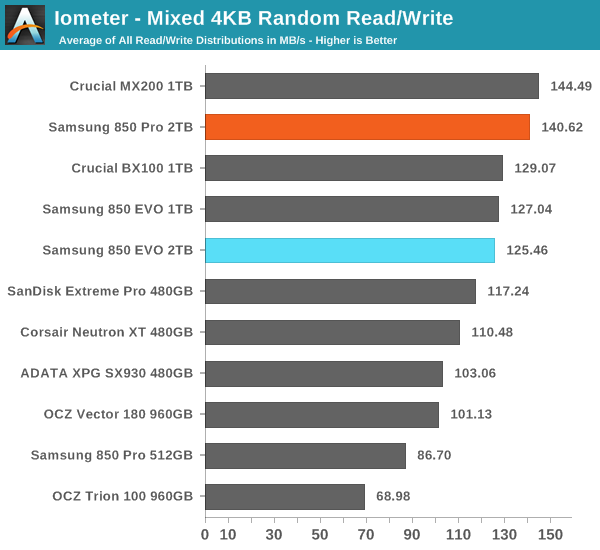
In mixed 4KB random performance the 2TB Pro shows rather significant gains over the 512GB model. I was always surprised how poorly the 850 Pro performed in this test, so it's good to see Samsung paying attention to this, especially since the performance increase comes with dramatically improved power efficiency.
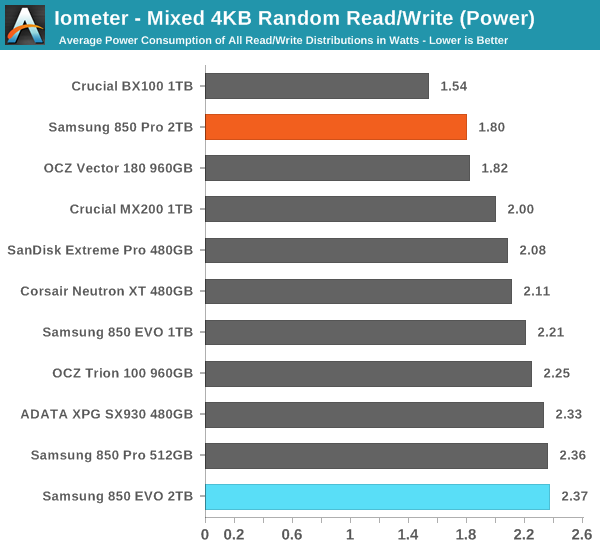
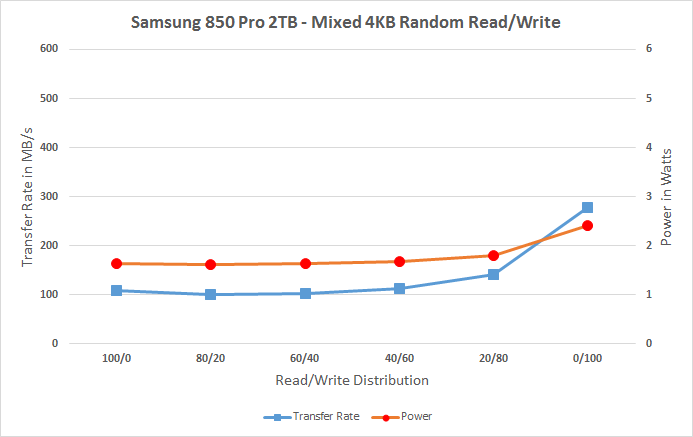 |
|||||||||
The 512GB Pro had performance and power issues once over half of the IOs were writes, but the 2TB model shows quite optimal performance scaling.
Mixed Sequential Read/Write Performance
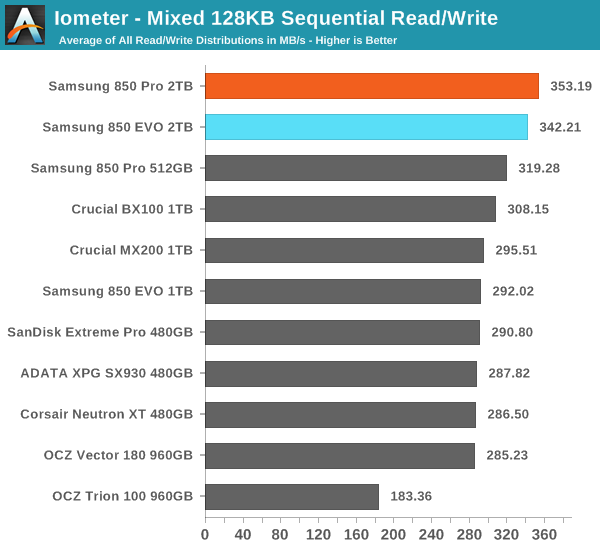
In mixed sequential workload performance of both the 2TB Pro and EVO is further improved with the Pro topping the chart. The 2TB EVO is again more power efficient than the 1TB model, whereas the 2TB Pro consumes only a little more power than the 512GB model (this was expected because large sequential IOs utilize multiple dies and with 2TB having more NAND there are more dies drawing power).
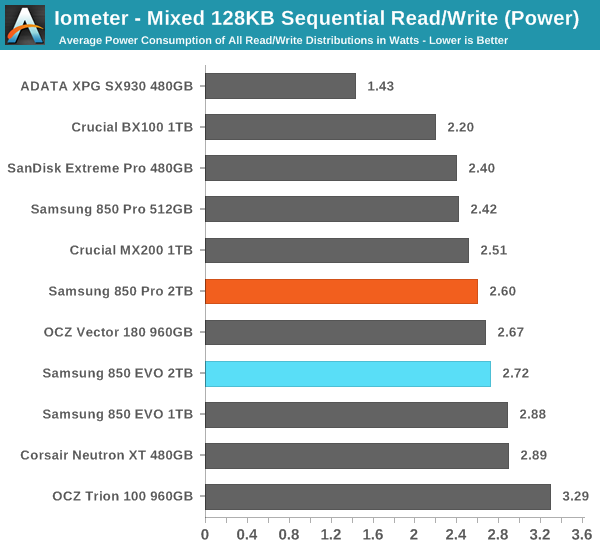
The improvement has been in the critical 60/40 and 40/60 distributions. Quite a few drives have an infamous "bathtub" curve where performance severely degrades, but the 2TB Pro and EVO are fairly consistent though all distributions. It's great to see Samsung improving mixed performance because typically it has been an area that has been forgotten in client SSDs, but under real world workloads IOs tend consist of both reads and writes.
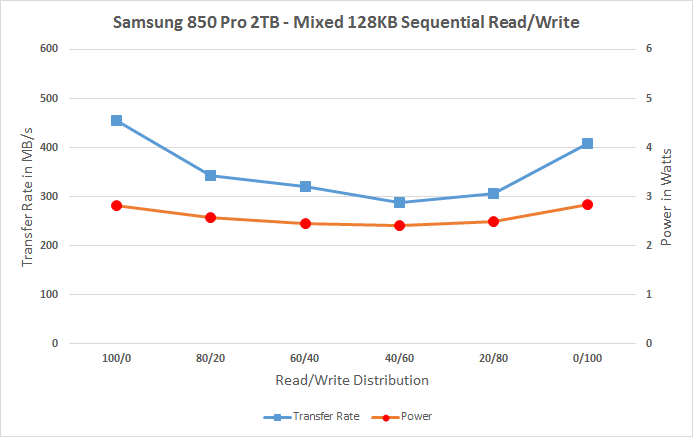 |
|||||||||










66 Comments
View All Comments
Kristian Vättö - Thursday, July 23, 2015 - link
The move to Windows 8 broke compatibility with that method since HD Tach no longer works. I do have another idea, though, but I just haven't had the time to try it out and implement it to our test suite.editorsorgtfo - Thursday, July 23, 2015 - link
Kristian, what would you consider the best SATA 6Gbps drive(s) with power-loss protection?editorsorgtfo - Thursday, July 23, 2015 - link
Judging from the 850 Pro and EVO PCBs, they don't even guard their NAND mappings. Or my eyesight is giving.Meegul - Thursday, July 23, 2015 - link
It's mentioned at the end of 'The Destroyer' test that the 2TB 850 Pro uses less power than the 512GB variant, with one reason being cited as possibly a more efficient process node for the controller. Wouldn't it be more likely that the move to LPDDR3 in the 2TB variant was the cause for the increase in efficiency?MikhailT - Thursday, July 23, 2015 - link
He said that on the final words page as well: "I'm very glad to see improved power efficiency in the 2TB models. A part of that is explained by the move from LPDDR2 to LPDDR3, but it's also possible that the MHX is manufactured using a more power efficient process node. "MrCommunistGen - Thursday, July 23, 2015 - link
Kristian, I like that you give a little bit of love to the Mixed Sequential Read/Write graphs.Honestly this is the 1 area that I still find myself tearing out my hair waiting for on my Mid 2014 rMBP 1TB. I do a lot of work with large VMs in VMware and from time to time I have to copy one.
Peak read and Peak write speeds on this SSD are quite good, often approaching 1GB/s, but mixed sequential read/write is capped to an aggregate total of 1GB/s (yes I realize that this is bus limited on a x2 PCI-E 2.0 SSD).
This is one area that I really look forward to seeing improvements in with x4 PCI-E 3.0 SSDs.
jas.brooks - Sunday, March 13, 2016 - link
Hey MrCommunistGen,Just wondered if you could shed some light onto the Mixed Sequential Read/Write significance for you. I'm not super-tecchy personally, so it doesn't mean very much to me in those words alone.
BUT, I have been experiencing some very frustrating behaviour on my rMBP late-2013 (with 1TB built in SS-storage). When I'm using Premiere Pro CC2015 with video projects over a certain size (I'm a pro cameraman and editor, so am using heavy XAVC-I video from a Sony FS-7), then I get crazy lags waiting for a sequence to open, or specifically when making copy&paste commands. I have noticed that my (16GB) RAM is often near full in these situations, and there is a swap file in action too (between 1-16GB).
Any thoughts on my problem? More specifically, any possible ideas/suggestions of a config adjustment that could improve my experience? Or, is it simply the case that I'm pushing my machine too hard, and need to get a 32GB-RAM-cabable laptop ASAP?
Thanks!
jason
jcompagner - Thursday, July 23, 2015 - link
So they now have a way larger package/die for the pro version?Because with the 1TB evo and 1TB Pro i got the picture
both are exactly the same hardware only the evo stored 3 in 1 cell and the pro 2
(128GBit / 3 * 2 = 86GBit pro)
But now they both have 128GBit for the evo this i guess just means more of the same stuff
But for the Pro this has to mean that it has way more cells 50% more. So the die of the 2TB has to be 50% bigger then a one of the 1TB right?
Kristian Vättö - Saturday, July 25, 2015 - link
The 86Gbit MLC and 128Gbit TLC dies are not identical -- the TLC die is actually smaller (68.9mm^2 vs 87.4mm^2) due to it being a single-plane design. A lot more than the number of memory transistors goes into the die size, so estimating the die size based on the 50% increase in memory capacity alone isn't really possible.karakarga - Friday, July 24, 2015 - link
Why the read and write speeds not increasing? 550~540 Mb/s read and 520 MB/s write speeds, may reach 600 MB's there are still headroom!